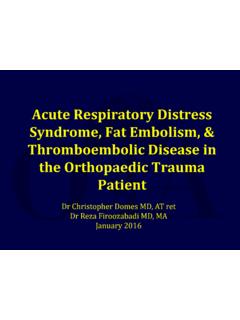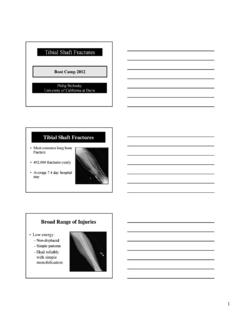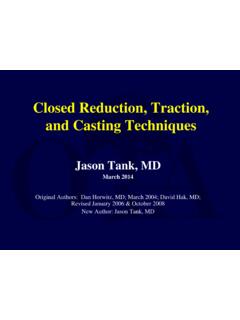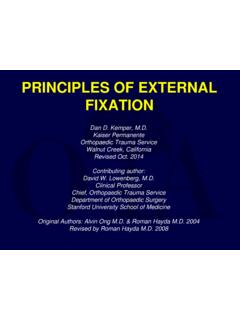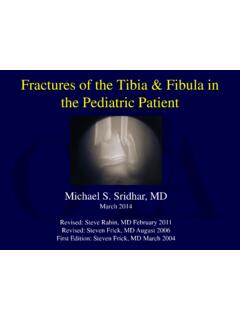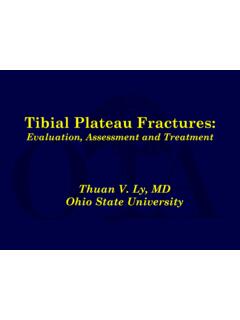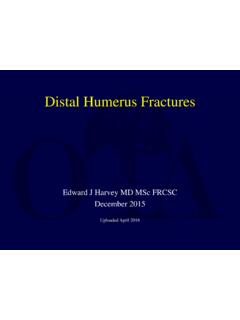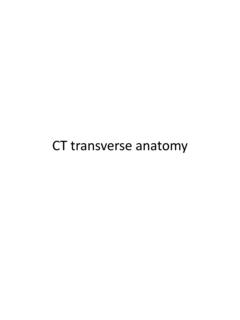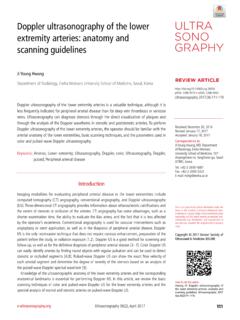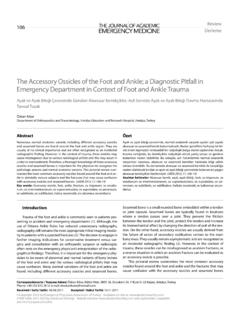Transcription of intertrochanteric femur fractures - ota.org
1 intertrochanteric femur fractures Alan Afsari, MD. March 2014. Topics epidemiology anatomy classification mechanism of injury patient assessment treatment rehabilitation complications Epidemiology 341k people visited EDs with hip fractures 90% were > 60y trochanteric : cervical 2:1. appox 227k trochanteric fxs per year; ~200k in elderly patients Epidemiology 20% mortality w/in 1 y (most w/in 6 m). $ billion spent on hip fxs in 1995 (of $ billion spent on all osteoporotic fxs Anatomy osseous anatomy is straightforward the soft tissue anatomy is more nuanced Anatomy the deep branch of the medial femoral circumflex vessel generally fractures are lateral and inferior to the vessel and blood flow is not compromised basicervical fractures potentially are at risk Anatomy note neck-shaft angle note the height' of the greater trochanter relative to the center of the femoral head the reduction should aim to recreate the patient's normal anatomy Anatomy when the centers are higher the trochs = valgus Anatomy when the centers are lower than the trochs = varus Classification AO/OTA.)
2 31-A proximal femur , trochanteric segment 1 2 3. the standard classification system not great for communication (too) many subtypes Classification - Stability stability may drive choice of implant stable fractures may be treated with a sliding hip screw unstable fractures may do better with intramedullary fixation Classification - Stability features of instability medial or posteromedial comminution large lesser trochanter fragment incompetent lateral wall'. transverse fracture above the lesser reverse obliquity extension to the subtrochanteric region Mechanism of Injury geriatric fractures most commonly occur from a ground level fall osteoporosis younger patients typically have a high energy mechanism motorcycle auto fall from height Assessing the Patient geriatric patient in addition to full assessment for other injuries prior functional level living arrangements comorbidities prior treatment for osteoporosis?
3 Young patients ATLS. Assessing the Patient shortened & externally rotated limb neuro exam vascular exam imaging Assessing the Patient imaging pelvis AP. hip 2v femur 2v . deformities? other implants? (you need to assess the whole femur Assessing the Patient imaging ct atypical patterns? mri searching for an occult fx Assessing the Patient imaging w/u hip pain after trauma greater trochanter fx on CT no pt unable to mobilize - MRI was fracture seen ordered - fluid consistent with across occult fx Assessing the Patient imaging mri searching for an occult fx a negative ct does not rule out an occult fx in geriatric patients Assessing the Patient imaging ct not routinely used for geriatric fractures helps with understanding the fracture in atypical patterns Associated Injuries geriatric patients look for other osteoporotic fractures shoulder wrist vertebral compression beware of head injuries in patients on anticoagulants w/u & treat osteoporosis Associated Injuries young patients ATLS.)
4 Like any other high energy trauma full secondary surveys on initial evaluation and after surgical intervention look for other injuries Treatment closed infrequently used even in nonambulators reduction and fixation is palliative for pain, hygiene Treatment open reduction and stabilization versus arthroplasty (primarily severe DJD). anatomic reduction favored over displacment osteotomies (ie. dimon- hughston). Treatment open (continued). choice of implant is controversial sliding hip screw (shs). intramedullary nail (imn). Treatment whatever implant is chosen . anatomic reduction prior to fixation**. implant won't reduce the fracture avoid devitalizing fragments joystick with pins need stable' fixation to allow early mobilization shs v. imn shs had been the standard device adoption of imn was made largely w/o evidence of improved results (initial results of imn had higher complication rates).
5 As of 2005, candidates sitting for abos were using more imn than shs shs v. imn evidence assessing for optimal implants is weak (low level, underpowered). early generations of imn (cephalomedullary) were prone to problems (ie., fracture at the tip) which have improved with improved design shs v. imn No recommendation for device based on patient outcomes.. future research recommendations better research' (paraphrased) (consistent use of outcome measures, assess and quantify surgical technique, data pooling). Treatment open (continued). arthroplasty insufficient data to determine advantage of arthroplasty over internal fixation improved clinical outcome with imn, no difference with function blood loss mortality Treatment - Timing expedient'. don't rush to surgery emergently'. get judicious' w/u (avoid the $1M w/u.)
6 Usually just delays surgery don't treat as purely elective book it for 2. days from now'. literature is observational selection bias for the patients who go to surgery quickest (healthier patients). Treatment - Timing surgery w/in 48h associated with decreased mortality no difference in mortality increase complications Treatment - Timing pts are less likely to return to independent living if delayed 36-48h 80% of pts w/o dementia returned to indep living w/in 4 mos (<36h). 31% of demented pts returned to indep living fewer pressure sores if <24h Treatment position - fx table with well limb extended incision ASIS - fx table LATERAL PF. position treatment with well limb JOINT. extended ANTERIOR &. POSTERIOR. GREATER. TROCHANTER. Treatment I make a stab incision so if i'm fighting soft tissue (adipose) I can adjust without making a huge incision (another stab).
7 Reduce fracture on the table Treatment pick a starting point that keeps the reamer from falling into the fx lateral medial starting starting point avoids more point lateral fx avoids more medial fx Treatment lateral view the pin should be anterior greater trochanter at the jxn of the anterior & middle 1/3's of the greater troch not centered! if it's centereed it won't align with the neck and the posterior greater trochanter shaft Treatment if it's too posterior distal end of nail anterior greater trochanter can abut the anterior cortex posterior greater trochanter Treatment guide the reamer down to avoid reaming into the neck or out laterally Treatment prior to proximal fixation add traction to eliminate varus (as needed).. Treatment perfect' lateral the nail is centered over the femoral neck and head then rotate the nail until the jig to direct the pin trajectory to the center of the head Treatment screw should be deep in the head, centered or lower on the AP, centered on the lateral lock distally if axial or rotational instability Treatment the sum of the distances on the 2 views should be at least <25mm (maybe less).
8 Treatment high energy reverse oblique in 32y man option for imn (risk to displace the coronal split at lateral cortex). or plate - ? maintain alignment concern for varus Treatment reduce and get proximal fixation articulated tensioner helps eliminate varus tensions the construct compresses the fracture Treatment healed and remodeled at 9 months Treatment implants removed due to pain (prominent implant). Rehabilitation early mobilization wbat immediately or within 1-2 weeks of surgery non-demented patients voluntarily limit weight-bearing on the basis of the degree of discomfort or apprehension that such weight- bearing causes' (self protected weight bearing). demented patients (they do what they want)? Complications (aside from mortality, ulcers, poor function). malalignment varus line through center of femoral heads should be at the top of the greater trochanter Complications basicervica l fracture Complications avn / collapse Summary 20% mortality in geriatric fx at 1 year no definitive evidence to guide implant choice if surgery within.
9 48h - mortality 36-48h return to independent living 24h complications (decubitus ulcers). surgical goal anatomic reduction with stable fixation to allow mobilization counsel patients and family about outcomes References Al-ani AN, Samuelsson B, Tidermark J, et al. Early operation on patients with a hip fracture improved the ability to return to independent living. A prospective study of 850 patients. J Bone Joint Surg Am. 2008;90(7):1436-42. Anglen JO, Weinstein JN. Nail or plate fixation of intertrochanteric hip fractures : changing pattern of practice. A review of the American Board of Orthopaedic Surgery Database. J Bone Joint Surg Am. 2008;90(4):700-7. Barton TM, Gleeson R, Topliss C, Greenwood R, Harries WJ, Chesser TJ. A comparison of the long gamma nail with the sliding hip screw for the treatment of AO/OTA 31-A2 fractures of the proximal part of the femur : a prospective randomized trial.
10 J Bone Joint Surg Am. 2010;92(4):792-8. Baumgaertner MR, Curtin SL, Lindskog DM, Keggi JM. The value of the tip-apex distance in predicting failure of fixation of peritrochanteric fractures of the hip. J Bone Joint Surg Am. 1995;77(7):1058-64. Bhandari M, Schemitsch E, J nsson A, Zlowodzki M, Haidukewych GJ. Gamma nails revisited: gamma nails versus compression hip screws in the management of intertrochanteric fractures of the hip: a meta-analysis. J Orthop Trauma. 2009;23(6):460-4. Butler M, Forte M, Kane RL, et al. Treatment of common hip fractures . Evid Rep Technol Assess (Full Rep). 2009;(184):1-85, v. Desjardins AL, Roy A, Paiement G, et al. Unstable intertrochanteric fracture of the femur . A prospective randomised study comparing anatomical reduction and medial displacement osteotomy.

